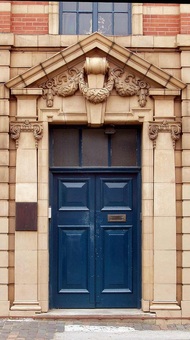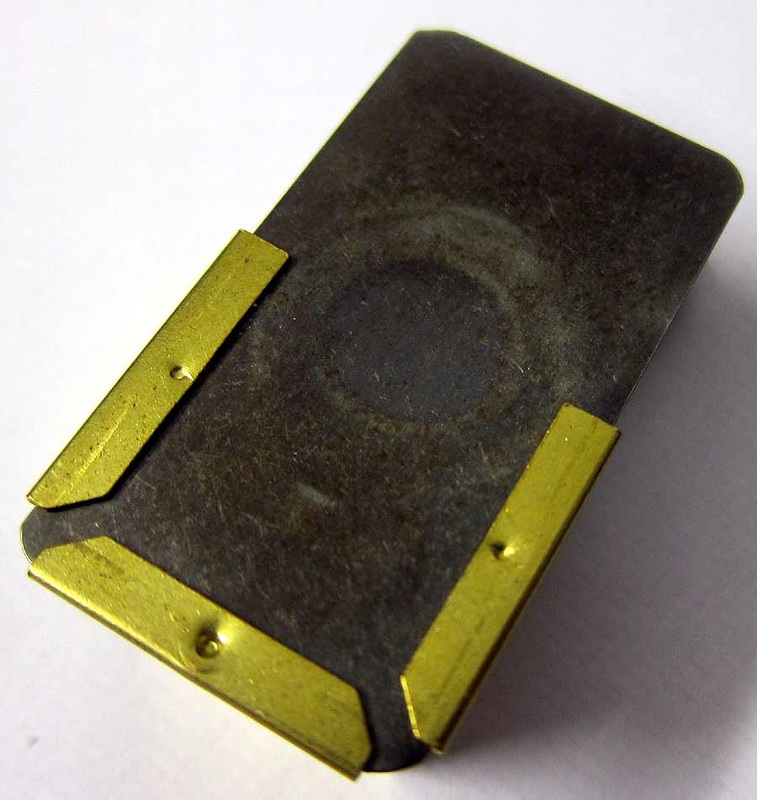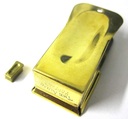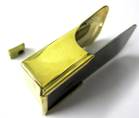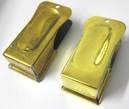WW2 Airborne Clicker - Technical & Background:Information relating to the Airborne Clicker including dimensions, weight, manufacturing process, replicas and other such useful facts. We would love to see pictures of your genuine or replica cricket regardless of condition. Feel free to contact us and we will get them listed with full credits (if you wish). |
|
The image to the left comes from the J. Hudson and Co. catalogue from the early 1940's. It shows the nickel (not chrome), version available for sale. This clearly demonstrates the clicker was available in 1944 and not made specifically for the 101st Airborne.
It also shows the correct makers markings and the punched hole in the nickel variation. The name and number of the item is also indicated which has been brought forward by us placing it on the box which comes with your clicker. |
|
Pictures of the J Hudson building - this is where the Normandy cricket was first made and is still made today on the same machines, dies and equipment. It is based in the Jewellery Quarter area of Birmingham, England.
The Jewellery Quarter is Europe's largest concentration of businesses involved in the jewellery trade, which produce 40% of all the jewellery made in the UK. It is also home to the world's largest Assay Office, which hallmarks around 12 million items a year. Historically the Jewellery Quarter has been the birthplace of many pioneering advancements in industrial technology. At its peak in the early 1900s the Jewellery Quarter employed over 30,000 people. This is a beautiful old Victorian era building which survived being bombed in WW2 by the Germans and continues to supply equipment to Armed Forces worldwide, including of course our Acme Cricket. |
Airborne Cricket - Technical Information:
|
Pictured to the left and right are the front and reverse images of the Cricket materials before being made up into the finished article.
Points to note are: the metals are pressed from the base metals - there is no modern CNC machining done on these; the 'R' on the reverse to help prevent them being passed as original WW2 Crickets. At this point the circle in the clicker mechanism metal has not been stamped. |
Identifying the differences between our genuine Acme cricket & Reproductions:
Please refer to the pictures above to identify the dimension's of a genuine Acme Cricket. Genuine Clicker weighs 15 grams.
- A. Length top middle to middle: 47mm
- B. Height base to top: 15mm
- C. Length of Steel: 50mm
- D. Width of 'Wings': 25mm
- E. Width of Steel: 21.5mm
- F. Width of base: 23mm
- G. Thickness of Brass/Nickel: 1.25 (this is not mm)
- H. Soldered internal joints - Yes (some had no solder). Only one of the current replica crickets have this soldering in the corners and this is very sloppy.
Replica 1: 6th JUIN 1944 Marked Clicker:
|
There is no intention to deceive with this cricket. It is made to commemorate the Normandy invasion in 1944. None of the features are identical to the genuine Acme Cricket above. It works and makes a nice clicking noise and seems quite sturdy although it is very bulky compared to an original.
It weights 14.5 grams. |
- A. Length top middle to middle: 54mm
- B. Height base to top: 18mm
- C. Length of Steel: 48.5mm
- D. Width of 'Wings': 26mm
- E. Width of Steel: 27mm
- F. Width of base: 28.5mm
- G. Thickness of Brass/Nickel: 1 (this is not mm), but relate this size it to the original above.
- H. Soldered internal joints - No.
Replica 2: French origin clicker:
|
This Normandy Cricket is very close to an original. It is sold on-line and in several French shops & Museums. Few the features are identical to the genuine Acme Cricket above but some are very close. It works and makes a nice clicking noise, although our one broke after several clicking sessions as the steel plate gave way. It weighs 17grams.
|
- A. Length top middle to middle: 47mm
- B. Height base to top: 17mm
- C. Length of Steel: 47.5mm
- D. Width of 'Wings': 24mm
- E. Width of Steel: 21.5mm
- F. Width of base: 24mm
- G. Thickness of Brass/Nickel: 1.35 (this is not mm), but relate this size it to the original above.
- H. Soldered internal joints - No.
Replica 3: 'U.S.' Marked Clicker:
|
This D-Day Cricket is nothing like an original. It is sold on-line mainly from American based stores. Few the features are identical to the genuine Acme Cricket and the 'US' stamping is totally fictitious, although it does seem to sell well! It works and makes a reasonable clicking noise. It weighs 17grams.
|
- A. Length top middle to middle: 54mm
- B. Height base to top: 14mm
- C. Length of Steel: 50mm
- D. Width of 'Wings': 25mm
- E. Width of Steel: 25.5mm
- F. Width of base: 27mm
- G. Thickness of Brass/Nickel: 1.30 (this is not mm), but relate this size it to the original above.
- H. Soldered internal joints - No.
Replica 4: 1/6th Scale Dragon Figures Clicker:
|
We had to include this little beauty in our list of replica D-Day clickers. This is a dragon 1/6th scale cricket, made from cast metal. Yes, it is actually made of metal. The top side is a great copy but unfortunately the bottom lets it down a little. It does not unfortunately 'click'. A fantastic little item for your Dragon 1/6th scale models. It weighs less than 1 gram.
|
- A. Length top middle to middle: 8.5mm
- B. Height base to top: 3mm
- C. Length of Steel: 7mm
- D. Width of 'Wings': 4mm
- E. Width of Steel: 4.5mm
- F. Width of base: 4.5mm
- G. Thickness of Brass/Nickel: 1.24 (this is not mm), but relate this size it to the original above. Its almost identical!
- H. Soldered internal joints - No. It is sold cast in metal.
Replica 5: Indian Made Clicker:
Please refer to the pictures at the top of page to identify the dimension's of a genuine Acme Cricket. Genuine Clicker weights 15 grams.
- A. Length top middle to middle: 47mm
- B. Height base to top: 15mm
- C. Length of Steel: 50mm
- D. Width of 'Wings': 24.5mm
- E. Width of Steel: 21mm
- F. Width of base: 24mm
- G. Thickness of Brass/Nickel: 1.19 (this is not mm)
- H. Soldered internal joints - No. There has been a crude attempt to solder the joints but it is such a mess it can easily be seen.
Many of the dimension's match the Acme Paratrooper Cricket. The easy way to identify this fake is to look at the poor quality soldering, the very cheap brass colour (hidden if aged), The marks on the rear of the cricket which are not present on the original, The very sharp top indentation and the incorrect crimping holding the steel plate in place. We have no doubt this clicker was made to fool people. Compare the pictures below and you will see why if you buy a genuine ACME cricket you are buying quality!
Replica 6: 2004 - 60th D-Day Anniversaire Cricket:
|
This Normandy Cricket was made to commemorate the 60th Anniversary of the D-Day landings in 2004. It was sold in several French shops & Museums. Few of the features are identical to the genuine Acme Cricket but several are very close. It works and makes a nice clicking noise. It was made as a commemorative piece and not to deceive. It weighs 15grams.
|
- A. Length top middle to middle: 47mm
- B. Height base to top: 16mm
- C. Length of Steel: 48.5mm
- D. Width of 'Wings': 24mm
- E. Width of Steel: 22mm
- F. Width of base: 23.5mm
- G. Thickness of Brass/Nickel: 1.19 (this is not mm)
- H. Soldered internal joints - No.
If you have a Acme Clicker Number 470 that has lost its capability to 'click' you can find our replacement 'tongue' instructions on this link.
All images and our crickets are copyright, J Hudson and Co. takes copying of information and their crickets extremely seriously and have already won several legal court cases. Don't risk it - do not try and copy the airborne cricket or our website material! If you want to use our material please email us.
|
|


